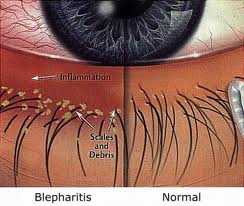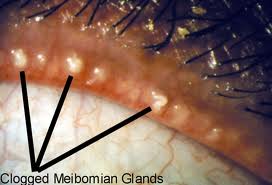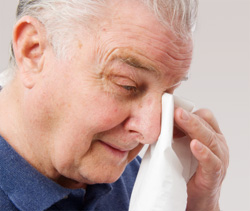How is Blepharitis diagnosed?
Blepharitis refers to inflammation of the eyelid margins. There are two broa d categories of the condition – Anterior Blepharitis and Posterior Blepharitis.
d categories of the condition – Anterior Blepharitis and Posterior Blepharitis.
Anterior Blepharitis affects the front part of the eyelid margin, near the roots of the eyelashes. It is commonly caused by bacteria that normally live on our skin, that produce an irritative toxin that causes inflammation. The lid margin often looks ‘crusty’ and when seen under a microscope, the appearance can be similar to dandruff. Anterior Blepharitis can cause the eyelids to become red, itchy and sometimes slightly swollen too.
 Posterior Blepharitis is also referred to as Obstructive Meibomian Gland Disease. The meibomian glands are located within the eyelid, and the pores of the glands open onto the lid margin, behind the roots of the eyelashes. The glands normally produce a special oily secretion for the tears. The meibomian glands sometimes become inflamed and blocked, causing a reduction in amount, and disturbance in quality of the oily secretions. This can not only cause eyelid margin irritation, but also has secondary dry eye effects on the ocular surface.
Posterior Blepharitis is also referred to as Obstructive Meibomian Gland Disease. The meibomian glands are located within the eyelid, and the pores of the glands open onto the lid margin, behind the roots of the eyelashes. The glands normally produce a special oily secretion for the tears. The meibomian glands sometimes become inflamed and blocked, causing a reduction in amount, and disturbance in quality of the oily secretions. This can not only cause eyelid margin irritation, but also has secondary dry eye effects on the ocular surface.
Who gets Blepharitis?
Blepharitis is very common indeed – 5% of eye problems in primary care are said to be related to blepharitis. People of any age can be sufferers, but it is more common in older people over the age of 50. It is not something ‘caught’ or inherited. The reason for some people developing blepharitis is poorly understood.
 What are the symptoms of blepharitis?
What are the symptoms of blepharitis?
People who have blepharitis may not suffer from any symptoms at all. However, for those that do report symptoms, one or any combination of the following symptoms are common:
- Irritation of the eyelids and/or eyes
- Redness of the eyes
- Sore eyelids – sometimes red and swollen lid margins
- Crusting of the eyelid margins
- Eyelids may stick together on waking in mornings
- Burning and tearing of the eyes
- Gritty sensation in eyes
- Pain on looking at bright lights (photophobia)
- Small eyelid margin cysts
How is Blepharitis diagnosed?
An eye examination will determine if blepharitis is present and whether it is anterior, posterior or a combination of the two. Not only are we are experienced at diagnosing blepharitis but with our slit lamp cameras we can show you how your eyelids appear and show you how their appearance improves as your treatment progresses.
How is Blepharitis treated?
The treatment for blepharitis is specific to the type and the severity, but below is a summary of some of the options.
Anterior Blepharitis -Lid margin cleaning
Recent research has shown that baby shampoo can destabilise the tears further, and is no longer recommended.
Use eyelid cleaning products, such as ‘Blephaclean’, and follow the packet instructions. Ideally do this when your eyelids are already warm (just after a warm shower for instance) as this helps the cleaning. If you need to treat MGD as well use a ‘moist’ heat bag, such as Optase Moist Heat Bag, rather than a ‘dry’ one, such Blepha EyeBag.
Posterior Blepharitis – MGD
Warm Compress – This softens debris on the lashes and/or softens or liquifies the oil in the eyelids.
Use an Blepha Eye Bag for 8 minutes as instructed in booklet supplied with it. Use the silk side (which will discolour over time), but if this is too hot use the cloth side.
Massage
Using a clean, dry finger massage the eye lid margin for a about 5-10 seconds per lid.
It should be a gentle pressure in a continous horizontal ‘figure of 8’ motion.
Expression
Press a finger gently from the base of the eyelid towards the lid edge so that any oil is expressed.
Carry out this cleaning regimen once or twice a day (as directed) for at least a month. Most people will experience a reduction in symptoms.
As symptoms improve you can taper your treatment but don’t just stop as the blepharitis will return.
Avoid irritants
Minimising chemical irritants that include certain eye drop preservatives and makeup can help reduce blepharitis symptoms. Remove all makeup thoroughly every evening.
Dietary Changes
There is some evidence to suggest omega 3 oils such as those in Flax seed can improve the quality of meibomian gland secretions.
Antibiotics
Occasionally, if there is marked bacterial anterior inflammation, or if there is an associated skin condition such as seborrheic dermatitis, or even Rosacea, your doctor may prescribe antibiotic eye ointment, or indeed oral tablets.
